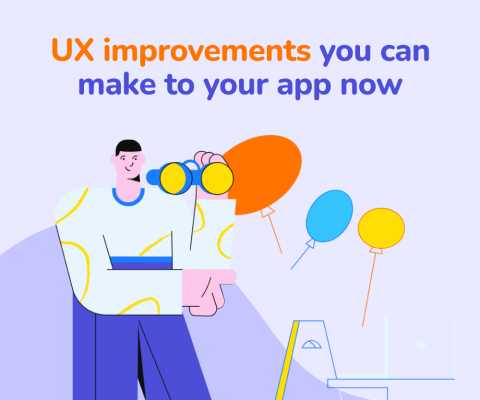December 17th, 2025, posted in for_founders
by Adelina
Got your attention? Oh, there it goes.
In the age of short form content, it’s getting harder and harder to grab someone’s attention. It is said that people leave a web page if they’re not engaged in 8 seconds.
But we’d argue it can be even less, especially if you’re dealing with a younger audience. They’re used to speed and to eye-catching content.
Making people wait too long for a simple task, these days, is a gateway to losing customers. Plus, it’s not too difficult for developers to speed up loading times.
But what, specifically, can affect your app’s UX in respecting the 8-second rule?
Page loading time
The biggest culprit is page loading times. If a user just wants to read a short article from your blog and it takes more to load than it would take them to read it, why would they stick around?
Loading times are the simplest way to deter users from using your app. Most of us are in a hurry, patience is at an all-time low, and our attention span is minuscule.
Google’s PageSpeed Insights is a great free tool that lets you test the load speed of any web page. Here’s what you can do using this tool:
- Create a list of crucial pages from your app, such as the homepage, sign up page, pricing, contact, or anything suited to your app type. In this list, include URLs to all these pages.
- Enter the page URLs into the page speed measuring tool above and note the results in the first list.
- Now you have an overview of load speeds on your most important pages, so you can decide which pages to improve.
Another thing you can do is have your quality assurance team take a look and evaluate your overall page speeds, but in a subjective way: ask them not to keep count, but to tell you what they’re feeling. Did the load time piss them off? Or did they feel okay with waiting? Alternatively, you can talk to your users and gauge their opinions.
Now, what can you do to improve your app’s loading times?
- Compress photo and video content. High resolution photos look great, but they generate very large files that in turn will take a long time to load on your website. Same applies for videos. Thus, make sure you compress them and test page speed once you do so.
- Talk to your developers about page optimization. There are simple things they can do straight into code that helps speed up your pages.
- Be minimalistic. Fancy animations look cool, but could slow down pages. Try to find a balance between what's necessary and what's over the top.
- Pay attention to actions taking place in your app’s backend. Can you limit them without affecting features?
In a less technical matter, you can improve how users feel about your waiting times by adding skeleton loading, spinners or loading levels. Give some progress so they know how long they need to wait for.

Design by Ayşe Doğan for Studio Scale
Big blocks of text
It’s hard to pass the 8 second rule when you’ve got enough text to span over 8,000 seconds. Now, in the case of blog articles, documentation or tutorials, you can’t really skimp on your word count.
Take a look at your app and evaluate how much text you use and how it’s structured. Does it look like big blocks of text, are they in small text sizes, is the contrast good enough? Have your quality assurance team take a look and write down which pages have big walls of hard-to-read text.
Another big issue in the case of big blocks of text is lack of visual hierarchy. You might lack headings and subheadings, which would make content easier to skim through. Headings are also great for SEO as it helps search engines analyze your content.

Source: Zeka Graphic
Here’s how to improve big blocks of text in your software:
- Use headings. Just like this article, divide content into blocks and precede each block with a heading. When getting to a more specific topic within a block, add a smaller heading, and so on.
- Use a larger line and paragraph spacing. Text is more breathable when you leave more space. This also makes it easier to read, and less intimidating for new users.
- Use images and graphs where suitable. Visual content adds a nice little break between big blocks of text and supports what you’re saying in your text content.
You can also try tools that measure how long it takes to read pieces of text. The Hemingway Editor helps with that and with improving your text’s readability - as big blocks of text might be difficult to read.
And so, it’s not just the length of your text content that can cause an issue. If your content contains too many details, some users might get bored and skim instead, or just leave.
The trick is writing as if you’re talking to someone. If you’re addressing people, talk like you’d talk to a person.
Lengthy onboarding
Multi-step splash screens when opening an app for the first time aren’t uncommon. But do people actually like them? You can argue they might not pass the 8-second rule, if done wrong.
It’s not a bad idea to introduce new users through a few intro screens that explain what your app does. However, it’s easy to jump into saying too much and unintentionally deter users from sticking around to read everything.

Design by Shakuro
When introducing users to your app, you need to get to the point and avoid wasting their time. Lengthy text might push users to close your app. Alternatively, if you really need to get some information across, use videos instead, animated photos, or simply let users skip.
Our tips:
- Limit the amount of steps/screens you show.
- Provide a Skip button.
- Get to the point. Don’t overexplain simple things, just introduce users to your app.
Another type of onboarding is the way you teach users to use your app for the first time. You might provide a video tutorial, a text-based one or maybe even a gamified step-by-step process that highlights key features and explains them one by one. The latter option is a quicker way to introduce people to a new app, but make sure to include a Skip button as well.
Page clutter
Another reason why your app might not pass the 8-second rule: your pages are too cluttered. You’ve got too much content, too many buttons and too many unique elements. A headache inducing layout is bound to put off users from sticking around.
When using too many elements in a tiny space, you’re creating a stuffy effect: there’s no breathing room, app sections end up very small and hard to see and read, and it’s overwhelming for anyone.

Screenshot by Softpedia
Here are some ways you can de-clutter pages in your app:
- Remove what you don’t need or make them collapsible. Too many clothes in your closet? Throw some out. In that same idea, get rid of text, images or form fields you can live without. Alternatively, if you might need some of these elements sometimes, make them collapsible and hide them by default.
- Add breathing room. Increase padding on your pages to add white space. This makes it easier to distinguish elements.
- Decide how much SEO content you really need. You might add more content just to reach a certain number of SEO keywords. But you could end up overcrowding pages instead. What’s the use of ranking high in search results if your bounce rate is high?
- Add more visual elements. Instead of words that act like buttons, use icons. Add images or graphical elements to add breathing room and texture to your pages.
Pages that require a lot of scrolling can also be considered cluttered and thus determine users to leave. So try to limit the amount of sections on your pages and use collapsible sections, accordions and carousels where possible.
The takeaway is, some UX issues clearly cause you to fail the 8-second rule. You can make small but important tweaks to your design in order to give a better user experience and determine users to stick around. But it requires you to look inside properly and ruthlessly judge your own software. What you think works really well might be pushing users away.
If you need help figuring out if your app passes the 8-second rule, let us take a proper look and give you a detailed run-down. We offer a free UI/UX assessment worth $3K - check it out here.

















